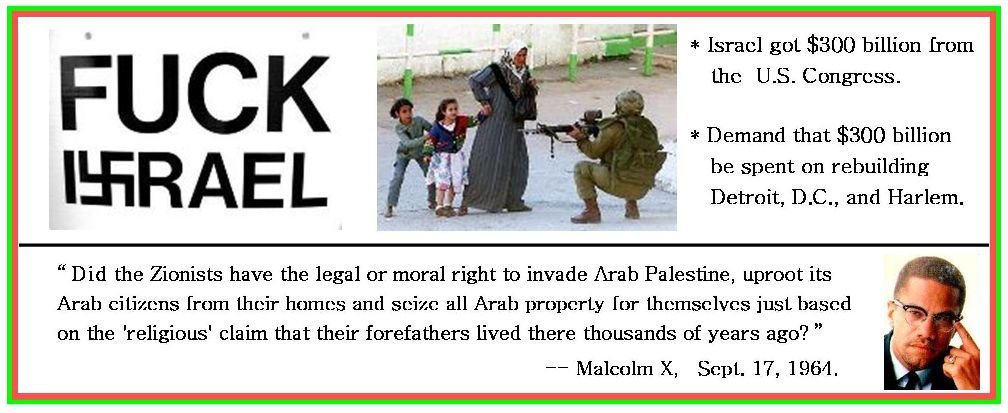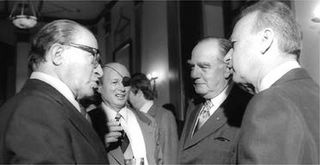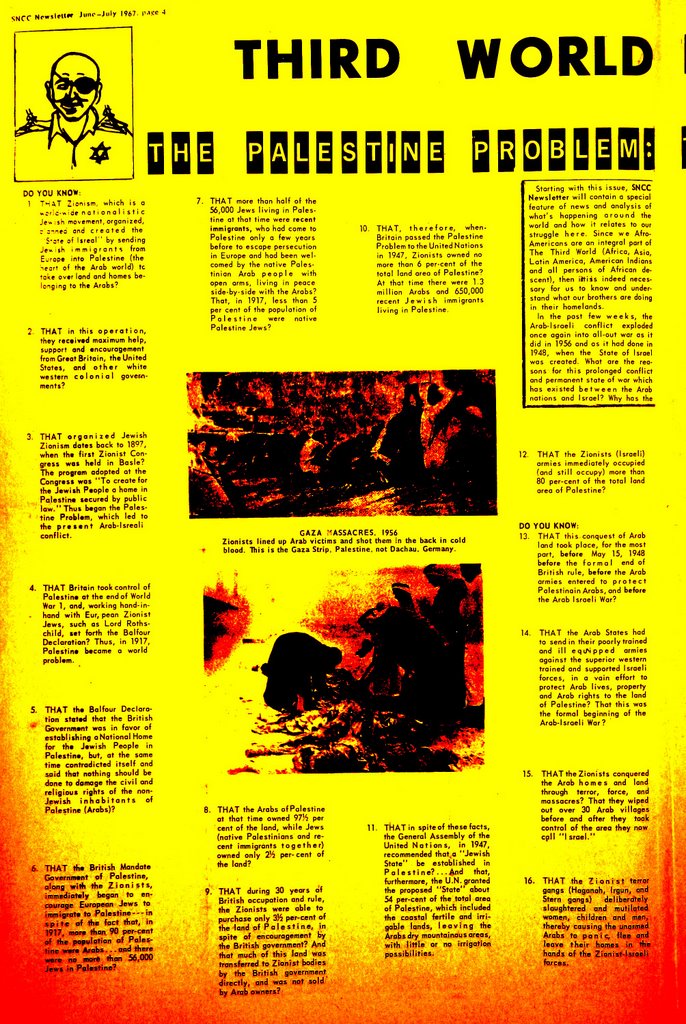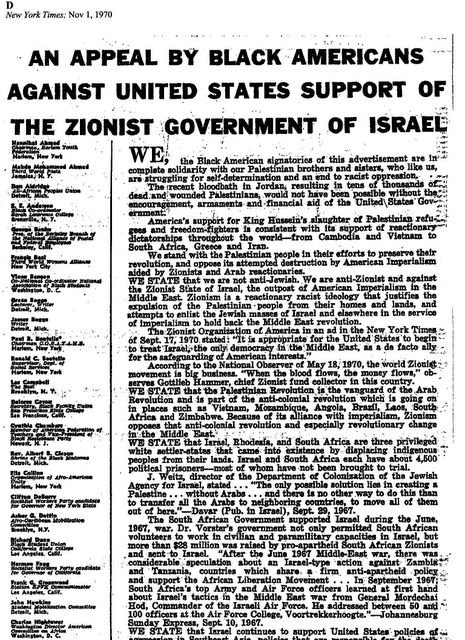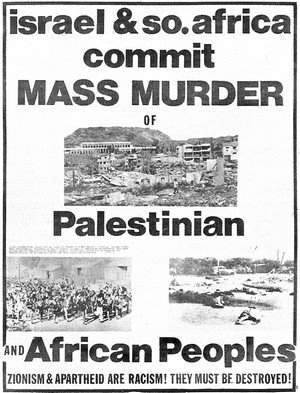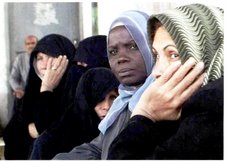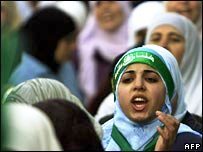
Desiring Westerners
This past fall I traveled to Boston to attend the Sabeel Conference on the “Apartheid Paradigm in Palestine-Israel” held in the Old South Church. Global warming was in full swing on the muggy weekend which coincided with the October 27th anti-war demonstrations organized by UFPJ. Sabeel — Arabic for “path” — is a Palestinian Christian organization billing itself as an “ecumenical, international grassroots peace movement that promotes nonviolence, human rights, international law, democratic principles and Gospel teachings on justice and peace-building”. Since the Zionist project was originated by Protestants hundreds of years ago and is now sustained not only by the murderous brutality of the Israeli army, the efficient ministrations of The Lobby and American largesse but also by the very edifice of Protestantism I was curious to see what the liberals among them were up to these days in this regard. The use of the word “apartheid” seemed promising so I bought my ticket and off I went.
Passing through the demonstrators stalwartly standing by Israel on Boylston Street brandishing shiny new blue-and-white placards, I entered the church and after receiving my conference packet entered the sanctuary where I was presented with an additional handout. Old South had apparently had taken flack beyond the demonstration outside for allowing such an anti-Semitic confab on the premises so the first document was a “public statement” signed by the Reverend Nancy Thompson defending the decision to host the conference as well within the fine liberal tradition of Old South. The Reverend further declared that Old South and the United Church of Christ “stand firmly in support of Israel…. firmly in support of Palestinian Christians” adding that UCC and Old South “grieve” for the suffering of both the Israelis and Palestinian Christians who both “possess narratives that are fraught with suffering, insecurity, injustice and anguish”. Perhaps Rev. Nancy felt that a robust display of Judeo-Protestant solidarity coupled with a pointed exclusion of Palestinian Muslims from the balm of her grief would certify the church’s bona fides to the critics without.
During the course of the two-day conference, celebrated leftist patriarch Noam Chomsky held forth in his soporific New York Times-quoting style on the topic of Boycott/Divestment/Sanctions and although he seemed to concede that BDS could kind-of-sort-of possibly be a pretty good idea at some unspecified future point he warned sternly that the groundwork has not been laid for its success and much organizing and education must be done first. Chomsky’s deep structure might therefore translate: “Take your time. Take lots of time. Let’s not rush out and inconvenience the Jewish state any time soon”. I prepared a question for the Professor on my conference-issue card asking if this meant that he had changed the position he took in 2001 when he told the Harvard Crimson, “I’ve probably been the leading opponent…of the campaign for divestment from Israel and of the campaign about academic boycotts”.1 But Chomsky toddled off at the panel’s conclusion after taking only one question from the audience so I was unable to learn the answer.
Jeff Halper of the Israeli Committee Against House Demolitions likewise exuded a bossy ambiguity. A native Minnesotan who plugged in his “birthright” but then apparently was dismayed to discover that his fellow Israelis were not so very nice, Halper exhorted the assemblage to take the apartheid-in-the-occupied-territories route because (this was said hurriedly, emphatically) “the single state is a non-starter”. The glaring, nay screaming contradiction of opposing both apartheid and a single democratic state thus hung in the air. Nevertheless, Halper made me wax nostalgic putting me in mind of my local UFPJ shop steward who waggled her finger at me some years ago and declared that a mysterious entity which she was pleased to call “our community” did not want to hear about the single state, and if I continued to rudely bring it up, I should go form my own group. She may even have concluded her scolding in the playground idiom of my youth, “So there!” but I cannot swear to it.
Canon Ateek delivered unto us ringing and eloquent words about Zionist apartheid. But he also stated that although Palestinians do not like the two-state solution they will have to accept it because the West — and here the good Canon sounded puzzled — “wants a Jewish state”. This bizarre Western desire was not elaborated upon however and thereby hangs the crux of the matter. In fact it hung right up there with the Halper Contradiction, suspended above the enormous sanctuary of Old South filled to capacity with mostly middle class white folk.
The West indeed wants a Jewish state, a state where the majority of the citizenry (perhaps all, if the Lieberman boys get their way) enjoy sole ownership of stolen Palestinian real estate based on some sort of DNA qualification. Why the West (and this includes the liberal, progressive and democratic West) wants this is a question that has never been effectively addressed by any pro-Palestinian or progressive group as far as I know. And it is this precisely this Western desire that lies at the core of the so-called difficulty of the problem. As you may recall after 9/11 there was a load of sanctimonious rubbish written about how Islam was in dire need of a Western-style “enlightenment” to bring it up to speed. But the fact that a majority of Western Christians and Jews harbor such a non-negotiable, religious/racist desire suggests that they would be better employed examining their own commitment to enlightenment principles rather than snottily preaching to others.
Imam Mahdi Bray, Farid Esack and Desmond Tutu offered up ringing condemnations of Israeli apartheid but to be sure they were all black and therefore on some level invisible to the nearly all-white audience. White privilege runs strong and deep in the likes of Old South as Rev. Nancy was careful to demonstrate. The Archbishop was uniformly charming although I felt he did make too much of us all being “the children of Abraham”. I’ve never understood the monotheistic regard for Abraham who abandoned one wife and son to die in the wilderness and then hawked the other about as a harlot to the local royalty. Not a particularly appealing father figure by any cultural measure. I rather agree with the great but deliberately ignored Lebanese historian Kamal Salibi who suggested that Abraham represents the West Arabian god of impotence.
Still I was in a Christian milieu, so I forgave the Archbishop because he comes from circumstances in which scripture might be said to carry some weight against oppressors although this was really only possible in South Africa because the West did not “want” a Boer state the way they “want” a Jewish state in Palestine. South African real estate — in spite of Boer hallucinations — was never coveted or covenanted the way Westerners feel that Palestine has been contracted personally to Protestants and Jews. Because the Bible constitutes the property deed to Palestine it is impossible to use it effectively in the struggle against the Zionist project because its supporters can simply flip to Genesis 13:15 and smirk “So there”!
Then up spake the bespectacled David Wildman, Executive Secretary for Human Rights & Racial Justice with Methodist Global Ministries. Wildman wielded religious metaphor to level accusation directly at the sea of well-fed white faces as he bade them examine the log in their own eye, in the eye of their churches and in the eye of the American left, a log that has long silenced debate on Palestine. Wildman charged that this silencing contributed directly to the apartheid now in place in Palestine and harked back to the example of the enormous anti-nuke demonstration in NYC in 1982 one week after Israel invaded Lebanon, when speaking out against Israel was explicitly banned by the organizers. It was bracing to hear Wildman use this little-known incident which I believe heralded the subsequent demise of the American left. For a millisecond I thought “Well shucks, put me down for a Methody”.
“Our reason for turning to Palestine is that Palestine is our country”
So now let us go a-logging. I am looking at an old postcard circa 1879 entitled “Oriental Group in Palestine Park”.2 The scene comprises a gaggle of Americans clad in oriental dress clustered round a Protestant chapel. The revelers are frolicking in Palestine Park, a scale model of the “Holy Land” constructed in 1874 on Lake Chautauqua, New York by the Reverend John Heyl Vincent as a visual aid for the legions of Sunday school teachers who flocked to the Chautauqua Institute to bone up on biblical history and geography. This first ever example of a theme park — that quintessential American construct — featured:
…a life-size Tabernacle built to the specifications given in Exodus, a pyramid, a model of Jerusalem, and a small scale replica of the biblical Holy Land itself—complete with a ten-foot-long Dead Sea, a smaller Sea of Galilee, and markers for important biblical sites—landscaped into the rocky terrain of the shoreline …which serves as the Mediterranean Sea.3
Established in 1874, the Chautauqua Institute spawned hundreds of “assemblies” throughout America, their popularity lasting until radio and cinema decimated their customer base. First and foremost the model at Chautauqua was liberal and Protestant. Upper and middle class Americans flocked to the Institute and its branches, first to imbibe Protestant party line and later to indulge in an array of adult ed courses, what Rudyard Kipling called “the apotheosis of popular information”. Chautauqua’s visiting luminaries included Amelia Earhart, Helen Keller, Thomas Edison, George Gershwin and at least nine presidents. Ida Tarbell, famed muckraker of Standard Oil, happily recollected cavorting on Palestine Park’s Mount Hermon as a girl.
Although there were many smaller precursors on American church grounds, Palestine Park is the iconic example of what geographer John Kirtland Wright called geopiety, “a deep religious devotion to a vision of the Holy Land concocted from a ‘curious mix of romantic imagination, historical rectitude, and attachment to physical space’ [emphasis added]”.4 Geopiety is a particularly Protestant obsession originating in England in the 16th century and culminating in the Balfour Declaration. Long before Herzl revved up the Jewish branch of geopiety, the Archbishop of York pugnaciously encapsulated the concept in 1875: “Our reason for turning to Palestine is that Palestine is our country. I have used that expression before and I refuse to adopt any other”.5
The Archbishop may have been ready for a fight, but Wright’s mix is not in the least curious. Palestine Park is no quaint bygone exhibit of exuberant 19th century American religiosity. Although the “historical rectitude” of situating biblical events in Palestine has melted away as biblical archaeologists continually come up empty-handed, Protestant theology maintains its fervid “attachment to physical [Palestinian] space”. Americans supersized their geopiety, objectifying it not only in Palestine Park but also countless miniature biblical re-creations in 19th century Sunday schools and sanctuaries across the country. Public constructional geopiety climaxed at the 1904 St. Louis World’s Fair which featured a ten-acre Jerusalem Exhibit in the center of the fairgrounds with full-scale replicas of such Palestinian landmarks as the Church of the Holy Sepulcher, Temple Mount, Solomon’s “stables” and the Wailing Wall. Imported “natives” provided picturesque accents for fairgoer’s amusement. Direct descendants of Palestine Park abound today in such venues as Holy Land, USA (VA), The Holy Land Experience (FL), Golgotha Fun Park (KY) and God’s Ark of Safety (MD).
Although today’s biblical theme parks have a definite red state tinge, youthful Protestant congregants in all states are still subject to Old Testamentary teaching and its obsession with property. In the liberal blue state Congregational Church of my youth, we Sunday school students built a scale model of the Tabernacle using specs from Exodus and surplus tile from teacher’s bathroom renovation. While we converted tiles into cubits, Johnston’s map of the Holy Land hung on the wall behind us and later when I was confirmed at age sixteen the testament bestowed on me featured the same map on the frontispiece. Only a few years ago during a rummage sale at a nearby ultra-liberal UCC church I spied the same map hanging in the choir room where the soft goods were on offer. Palestine Park and its derivatives are simply tangible examples of historic Protestant ownership regard for Palestinian real estate. It is precisely this theological component that now underpins Western insistence on a Jewish state in Palestine.
So while the great-great-grandparents today’s Palestinians were tending their fields and orchards and plying their crafts all unawares, Americans in Arab drag acted out their ownership fantasies in a Palestine theme park. Mind you, Palestine Park and the American tradition of biblical re-creation is only a small part of what is a long dense tradition of mainstream Protestant Zionism which includes such 19th century political milestones as: London Society for the Promotion of Christianity Among the Jews (1809); London Memorandum on the Restoration of the Jews (1839); Gawler’s Association for Promoting Jewish Settlement in Palestine (1852); and the Blackstone Memorial Petition presented to President Harrison entitled “Palestine for the Jews” (1891).6
All of these proto-Zionist constructs (which by the way contained elements of anti-Semitism) were created to realize Biblical prophecy for political ends. An even more pervasive and influential strain of this Protestant desire is scattered profusely through British and American literature, culture and nomenclature. All of these political and religious desires constitute what the late Israel Shahak identified so eloquently as the “weight of history”. It is important to understand that to this day this historic desire weighs on the Christian West on all levels — from right wing dispensationalists to the liberal clergy to the ranks of the anti-war progressives. That the West “wants a Jewish state” — whether consciously or not — is what enables the continuing bloodshed and injustice in Palestine and even Iraq. It is crucial that these desires be “dragged into the light” using Shahak’s example:
… politics is an interaction between realistic considerations… and ideological influences. The latter tend to be more influential the less they are discussed and ‘dragged into the light’. Any form of racism, discrimination and xenophobia becomes more potent and politically influential if it is taken for granted by the society which indulges in it. This is especially so if its discussion is prohibited, either formally or by tacit agreement. When racism, discrimination and xenophobia [is] being fueled by religious motivations it is like its opposite case, that of antisemitism and its religious motivations.7
The unexamined historical weight before us is the Protestant theology of real estate — the long Protestant theological desire for a Zionist project. Self-examination is particularly difficult when religion is involved.
Former President Jimmy Carter writes candidly of his life-long “infatuation” with Israel and describes the giddiness he felt the first time he visited Israel, a giddiness experienced by the thousands of British and American travelers who flooded “their” Palestine in the 19th century and then published equally giddy accounts of their travels which enormous body of work constitutes a literary phenomenon unprecedented at any other time or place. Nevertheless, Carter — like Halper — is unable to violate the “biblical” borders of Israel: Apartheid is to be found only in the occupied territories and Palestine Park itself is a “democracy”. Progressives, smugly thinking themselves liberated from such baggage, are particularly loath to examine the personal impact of this historical religious weight and instead seek refuge from the effort by hiding behind the issue’s “complexity” and other ruses. No doubt they are all held back by a certain reluctance to relinquish their G-d given right to frolic in Palestine Park.
- David Weinfeld, “Chomsky’s Gift”, Harvard Crimson, Dec. 12, 2002. #
- The History Project, UC Davis #
- Timothy Beal, Roadside Religion, 2005, p. 28. #
- Ibid., p. 27-8. #
- Issam Nassar, “In Their Image”, Jerusalem Quarterly, October 2003. #
- For a detailed historical chronology of Christian Zionism, see Mohameden Ould-Mey, “The Geopolitical Genesis and Prospect of Zionism”, Political Geography, 2003. #
- Israel Shahak, Jewish History, Jewish Religion: The Weight of 3000 Years, 1994, p. 2. #
